With SEMrush going public on the NYC stock exchange SEO tools have now become more mainstream, I thought I would write an article on which SEO tool is better: SEMrush vs Ahrefs. There is much debate as to which is the better SEO tool: Ahrefs or SEMrush. Over the years, my SEO journey has taken me down many SEO tools path, MOZ was my gateway SEO tool then got more serious with link building and registered an account with Majestic SEO (Shout out trust flow metric) then dabbled in SEMrush which eventually led me to become an Ahrefs Advanced Package customer. Being an Ahrefs daily user, I will need to preface this article as there may be a slight bias but I will try my best to keep this as neutral as possible. The features I will detail are the overview (high level) sections of each SEO tool. Both SEMrush and Ahrefs offer an abundance of research features and to keep this article from being longer than the Lord of the Rings trilogy, I will focus on high-level user experience (UX), keyword research, link building analysis, pricing and reporting.
USER EXPERIENCE (UX):
Both Ahrefs and SEMrush boast a slick UX and are beautifully designed, extremely fast and easy to navigate. UX is very important when choosing your SEO tool due to the number of hours you’ll be spending on their interface. Link building and keyword research can be labour intensive so choosing tools that are easy on the eyes and provide quick navigation goes a long way in making a comfortable experience. Let’s look at their client overview dashboards and the overall look and feel of the platforms.
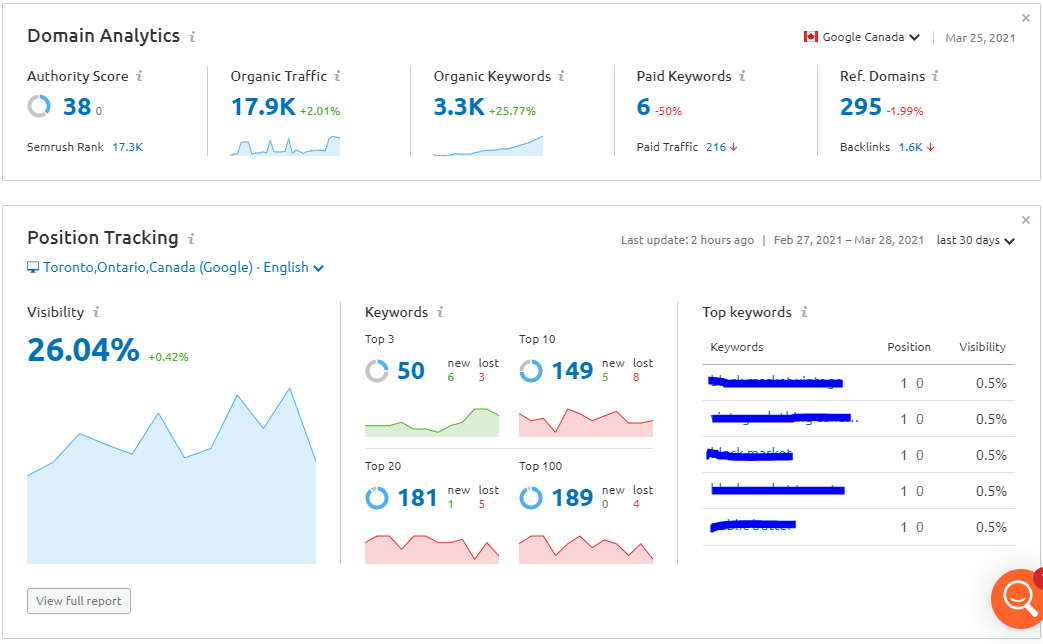
Above is the SEO Dashboard for SEMrush, which displays an overview of your project. This section provides a great overview of your keyword rankings, movement and traffic analytics fed from your client Google Analytics & Webmaster tools accounts. Moreover, it provides you with an on-page site audit and an overview of your backlink metrics. This is gold for SEO as there is no need to navigate multiple windows to attain insights on your user traffic metrics. The API syncs directly with SEMrush providing you with useful information from Google Webmaster Tools & Analytics in a clean organized dashboard.
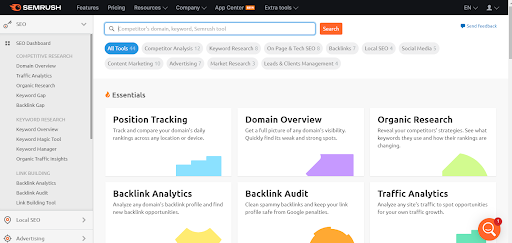
Above displays the SEMrush navigation menu which allows users to pick specific tools when wanting to roll up their sleeves and do some competitor/niche research. This is helpful as each tool’s data can be pulled into an SEO audit or proposal that will provide useful data to assist in better understanding your competitors and niche.
USER EXPERIENCE: AHREFS
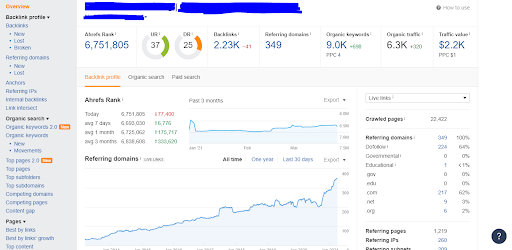
Above displays the client overview dashboard for Ahrefs, compared to SEMrush it lacks a lot of the metrics and is hyper-focused on link building. Each of the tool’s features is easy to navigate to on the sidebar which gives the user a quick way to find keyword movements and new links to attain. The issue with this dashboard is that it does not feed the data from Google Analytics & Webmaster Tools so you lose out on the pinpoint accuracy of your user traffic movements like on the SEMrush dashboard.
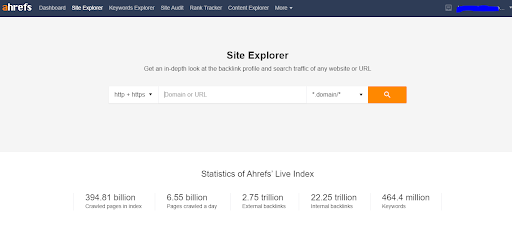
Above displays Ahrefs navigation which provides you with the high-level tools to roll up your sleeves and do some competitor research or client/niche audit. The UX is appealing and the tools are extremely fast. Each feature provides valuable insight into the site/niche you wish to research. . As an SEO expert, I understand what tools I need to use for my research whereas someone new to the SEO game could be overwhelmed by SEMrush so Ahrefs could be an easier way to start.
I find the look and feel of Ahrefs to be more pleasing to the eyes and love the nighttime mode function. The modules seem to pop more than SEMrush which is helpful when spending hour upon hour pouring over link profiles and organic keywords. I prefer the Ahrefs design.
VERDICT
As an SEO expert who has been in the game a long time the SEMrush UX is excellent and is easy to navigate – Someone new to SEO may have difficulty with the tool as there is a lot of features and could seem a bit overwhelming. I do like how the Analytics and Webmaster Tools feed directly into SEMrush to provide insight on how your onsite and offsite SEO work is being rewarded. Since it is right on the dashboard it saves a lot of navigation time. For me, logging into SEMrush to do link-building research is not as enjoyable as Ahrefs. I am compelled to log into Ahrefs and get my hands dirty – I believe this is due to the Ahrefs UX being much better. While Ahrefs lacks the Google API, the simple design of their dashboard and navigation make it a much more enjoyable user experience.
USER EXPERIENCE WINNER = Ahrefs
KEYWORD RESEARCH
Much like a starting point for any SEO audit, keyword research is where we’ll start in this overview. Keyword research plants the seed for your SEO roadmap and it grows to link building and other onsite and offsite implementations. Both tools offer a robust keyword research offering so let’s dive right in!
SEMRUSH KEYWORD RESEARCH
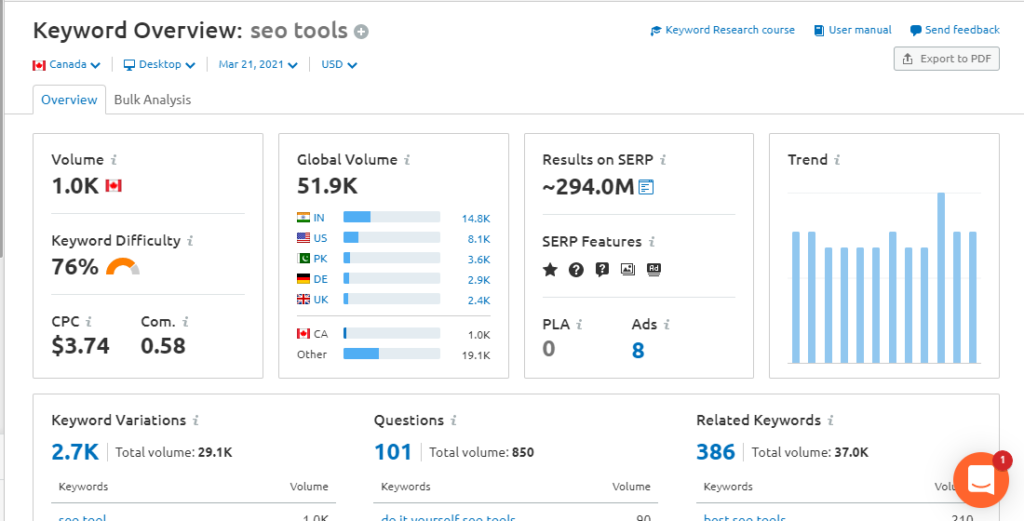
The above screenshot shows the SEMrush dashboard overview for the search term ‘SEO Tools’. SEMRrush gives you an overview of a few metrics I generally look at when doing research; volume (amount of monthly searches), difficulty (how hard it will be to rank for this term) and CPC (cost per click). These metrics provide you quick insights to understand if the search term is worth your while to target. The SEMrush keyword overview gives great initial keyword metrics and allows you to attain crucial data to know if the keyword should be used in your roadmap. I like the layout of this tool and it provides quick access to the main metrics you need while not overwhelming you with non-beneficial metrics.
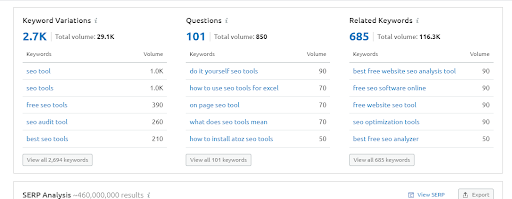
This next screen capture shows keyword variations from our initial keyword search. This is handy if you were creating a blog post or service page around the keyword, or when creating your onsite SEO strategy around these variants to use for your content. SEMrush provides you with a great selection of related keywords that are lower volume and easier to rank, by inputting them into your keyword roadmap will give you a better opportunity to rank for these terms in the search results. SEMrush does a great job of presenting the high-level keyword variants, questions & related keywords; you can even expand your search by clicking “view all” which provides you with an even wider idea of the search terms that you may want to target.
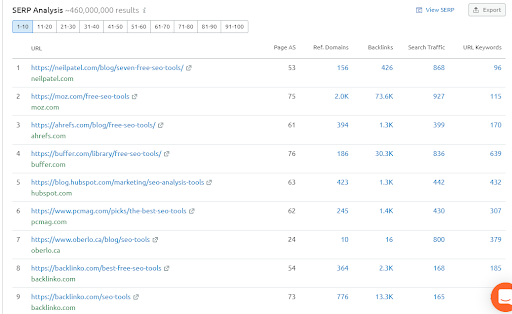
Above is the SERP analysis (which sites rank for this search term in Google) accompanied by metrics indicating the website’s link profiles, authority, traffic and related keywords. This gives an excellent view into what it will take to rank at the top of the search results for this term. For example; in the screen capture we see the lowest authority of a site ranking for this search term “SEO tools” is 24, so, you will need at least 24 domain authority and around the same number of backlinks to appear in the top 10 Google search results for this search term. This section is helpful for related keyword research and to understand what keywords your competitors are targeting, making it great for optimizing your onsite keyword research strategy.
AHREFS KEYWORD RESEARCH

Above is a screen capture of Ahrefs keyword analytics overview for the same search term we used for SEMrush; ‘SEO tools.’ The metrics are similar as it shows volume, CPC, difficulty and national reach. The metrics are different for each tool as the search volume in Canada is nearly double in Ahrefs keyword overview dashboard. Let’s dive into this a bit more.
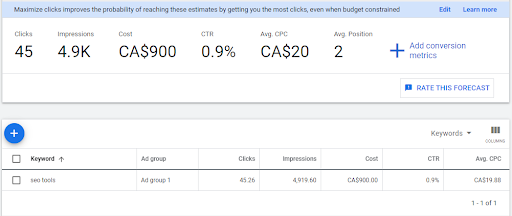
The screen capture above is the same search term in the Google Ads keyword forecast tool. This shows nearly double what Ahrefs is displaying for search volume in Canada (nearly 5k in April). While this metric could be inflated as Google set by default in location targeting of Google ads “people who are likely to be in or regularly present in your targeted areas, as well as those who show interest in your targeted geographic areas.” Meaning the impressions are inflated as it could be people in various parts of the world who searched ‘Canada’ once and ‘SEO tools were added to the search volume. This leads us to believe that neither are exact and to gather the most accurate data you would have to see the impressions of a site currently ranking in the top ten of the search results. However, the metrics from both SEMrush and Ahrefs give you a good idea of volume to inform your keyword research.
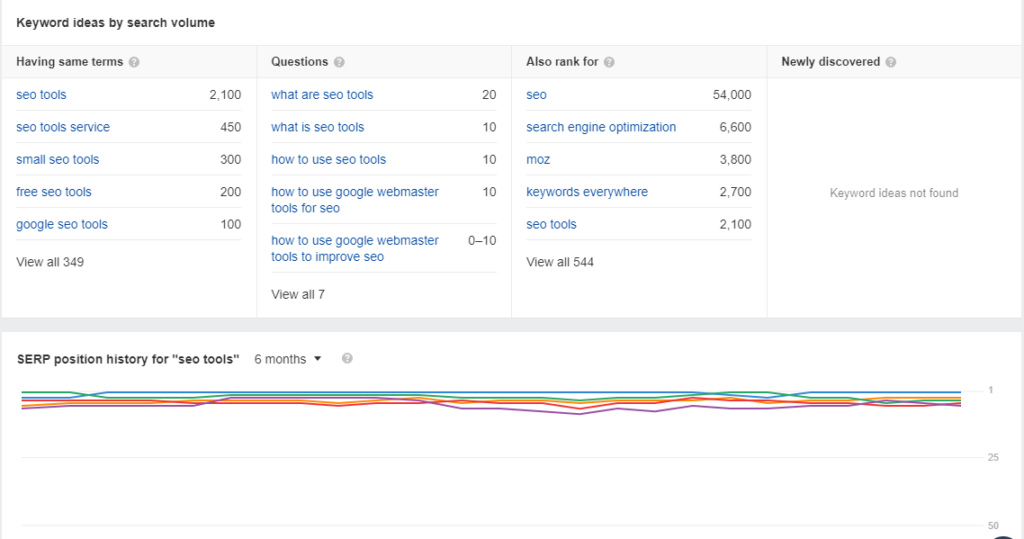
Above we see a screen capture of related keywords Ahrefs provides you when searching for a high-value broad term like “SEO tools”. These are similar to SEMrush as it provides the same related terms/questions but one slightly different metric; “also rank for”, meaning what keyword the sites at the top of the search results keywords they also rank for. Is ‘also rank for’ this a beneficial metric Ahrefs provides you? For keyword research and content building I would suggest no, as they are very high level and broad where we want to get into the nitty-gritty, SEMrush gives you more access to this in their dashboard. Additionally, the variations are different with SEMrush and are more accurate in this case. Ahrefs shows more global-related keywords. For example, ‘SEO Tools service’ is a variant Ahrefs provides which could be a non-first language English speaker who searched this term, so this leads us to believe that SEMrush is more nationally native English speaking targeted.
VERDICT
Both tools provide excellent insights for keyword roadmap research. While I mainly focus on overviews in this article, both tools can get more into the nitty-gritty that will provide you with the opportunity to find low-hanging fruit keywords. As a basic overview tool, I will have to give this one to SEMrush as it appears their volume and difficulty metrics are more accurate than Ahrefs.
KEYWORD RESEARCH WINNER = SEMrush
LINK BUILDING RESEARCH
Link building is a crucial part of search engine optimization and both SEMrush and Ahrefs offer robust tools to perform your link building research. Both have similarities, as we found in the keyword research but some features set the two apart. In this section, we will dive into the link-building overview functions of both tools and try to deem which is better.
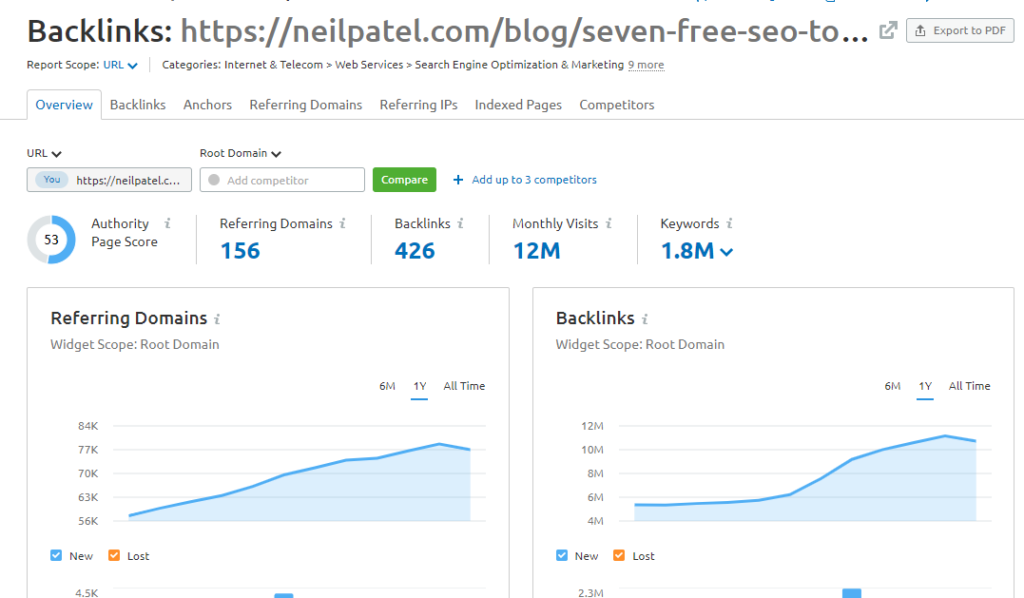
Using the same search term from above; ‘SEO tools’, I pulled the link analysis for the top ranking website in the Google search results. The above screen capture shows the SEMrush backlink overview of the website. We can see there is a clean synopsis of the site showing page authority, referring domains, backlinks, monthly visits and keywords. This dashboard gives great insight into the amount of referring domains and backlinks you’ll need to attain top ranking for this particular search term. So when creating your link-building strategy you know that it will take a large number of strong authority links to attain the top spot. In addition to the overview, SEMrush allows you to navigate to specific metrics like the number of backlinks, anchors, referring domains, referring IPs, indexed pages and even competitors. This is extremely useful if you are doing your initial backlink profile audit of the keywords and competitors.
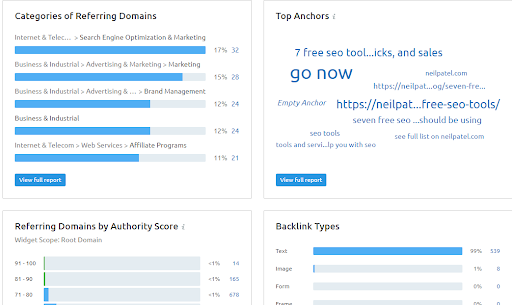
The screen capture above displays the 2nd portion of the SEMrush overview for the top ranking website for the search term ‘SEO tools’. This section provides insight into categories of referring domains, top anchors, referring domains by authority score and types of backlinks. Let’s unpack each one. Categories of Referring Domains are beneficial because when creating your link-building roadmap you know which category of the domain you should attain a backlink to have a chance to rank in the top position for the search term. When creating a target list of links to attain or content to create in hopes of getting an organic link to your site you should know the category niche of content you want to create to attain the link. The Top Anchors section is helpful to understand the keyword text you want to embed into the site to increase visibility for this search term. We can see that the page we are reviewing uses the exact match keyword sparingly while embedding the anchor text as it’s lower down on the top anchor section. Referring Domains by Authority Score is also helpful to understand what link authority (strength of website) you want to attain a link from when attempting to rank for this keyword. And finally, Backlink Types; there is a multitude of ways to attain a link, you want to see how the top-ranking websites attain the link through text, image form, frame and proceed to build your strategy around this. This overview is extremely helpful when building your backlink acquisition roadmap as knowing all of them before launching your strategy can put you in a place to succeed
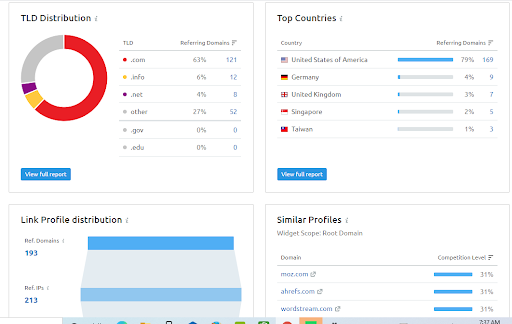
The screen capture above is the final section of the SEMrush backlink overview. This highlights the top-level domain, or TLD (.com, .info, .net), top countries, profile distribution and similar profiles of the top-ranking site for the “SEO tools” search results. This again is very helpful when doing your high-level link-building research as understanding the types of TLD and the target countries you want to attain backlinks from before launching your outreach and content is important; as you may want to target a specific local when creating your roadmap. Furthermore, understanding the link distribution ie; several referring domains, unique IPs and the domains that have similar links pointing to them. All of this information is handy when creating your roadmap and SEMrush does an extremely good job of providing you with the information with insightful modules and opportunities to dig deeper into each section.
AHREFS BACKLINK RESEARCH
Ahrefs link building overview differs slightly from SEMrush as they do not have a dedicated page for this. Their main overview page we touched on previously is the one you will be using for your first look at high-level link-building research. This is positive and a negative – the positive is that Ahrefs does not overwhelm you with options, it’s all housed in one section, but the negative is it’s slightly less robust than SEMrush. Let’s dig a little deeper below.
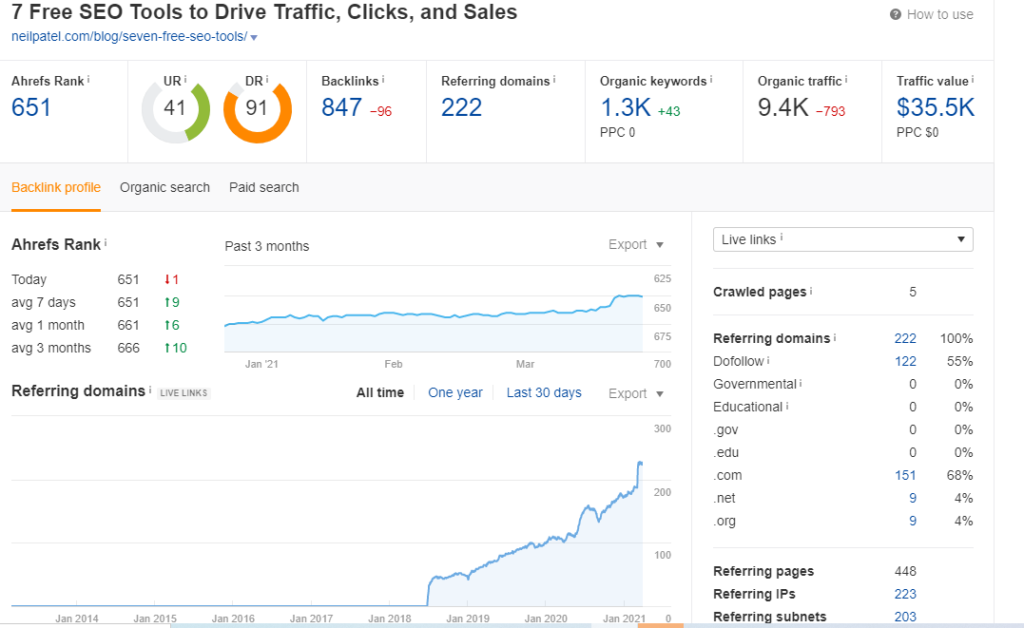
The capture above is the Ahrefs overview for the top ranking site for ‘SEO tools’ – this section is clean and provides you with the essentials to understand what you are dealing with to rank for this keyword “SEO tools.” The URL authority, the number of backlinks and referring domains are essential data to understand what you will need to achieve to rank your site at the top of the search results. The metrics/graph below the initial overview show if the page is still attaining links and at what rate. The sidebar indicates the TLD of the referring pages – this is helpful when you create your link acquisition list to understand what TLDs you should be going after.
Again, we see a bit of discrepancy between Ahrefs number of backlinks (847) and SEMrush (426) with Ahrefs showing nearly double the number of links! Let’s look at the top DO-FOLLOW domains each SEO software pulls to see if there are any variations on how the bots crawl and rank the top links pointing to the URL entered for the “SEO tools” keyword.

Above is the screen capture of Ahrefs top twelve DO-FOLLOW backlinks sorted by page authority pulled from their research software. These are all links that could be entered on your target list as they appear to be quality and attainable.

Above are the top twelve SEMrush DO-FOLLOW backlinks sorted by page authority. I have highlighted the links that do not appear on the Ahrefs list. We can see there are only three links that correlate with the Ahrefs top twelve ranked by page authority. Again, the links provided are all high quality, attainable and should be added to your target list and content creation acquisition list.
What does this tell us?
I believe this tells us that SEMrush & Ahrefs bots crawl and score web pages differently. Ahrefs attains more volume of links as we could see from the output of the number of backlinks while SEMrush has a lower volume of link output. This could be the reason for the discrepancies in scoring and ranking as Ahrefs sorts more links but when I searched a particularly high-value link that showed on SEMrush it did not appear in the Ahrefs list – this could indicate that Ahrefs misses some quality links in their high volume link crawls.
It is difficult to decide which is better as both of the top links for each software are quality. I believe to ultimately determine which is better you must create two similar web pages with the same content/design and attain the backlinks separately from the links pulled above. Once this is completed, you want to add a keyword rank tracker in the software for “SEO tools” and track which page ranks higher after 3-6 weeks. This will be the deciding factor to which is better. For now, I think this is a good thing that different links are appearing as it shows that you are getting a variation from both tools and it could be that you use a mix of both tools (if you have the budget) to do your link building research as you will have a larger list of high authority links to add to your target list.
VERDICT
While both Ahrefs and SEMrush overview features are similar it comes down to what works for you and your link-building strategy. While I prefaced this article that I have been using Ahrefs for all my link-building strategies for a few years now. I have proven results with the link acquisition targets the software provides I will need to go with Ahrefs on this one. While creating this article I had access to both tools and I only used SEMrush for a week but still went back to Ahrefs when I needed quick information. I would suggest trying both and determine which is best for your link-building strategies.
LINK BUILDING RESEARCH WINNER = Ahrefs
FEATURES & PRICING
These two tools are the most used in the industry, you tend to see that their pricing and features are similar as not to price themselves out of the market. Regarding features, you will also find once one tool launches a new feature the next will launch the same in the following weeks or months – for example; SEMrush offers Google Data Studio API and the following week Ahrefs announced a partnership with Supermetrics (data studio reporting software). This section provides a review of some of the features available on both tools and tries to pick a winner.
PRICING SEMrush
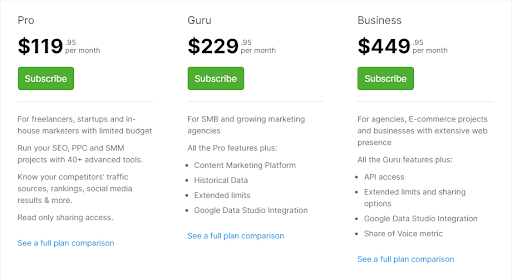
Above is a screen capture of the SEMrush pricing scheme, I would recommend the Guru package for anyone who has 8+ clients on retainer and uses the tools daily. The Pro package is acceptable but the limits will cap your research and you’ll find yourself opting for Guru in the near future. Take the dive and do yearly as you’ll save 18%!
PRICING Ahrefs

The screen capture above shows the Ahrefs pricing model. Their model is slightly different as their Advanced Package is slightly lower, but they offer an Agency Package that allows additional keyword tracking and crawls. The Agency Package is handy if you have a large staff and manage large sites with many pages as you will have increased keyword tracking, seats and site audits. If you have the budget the Agency Package is great but I would think most larger agencies use other tools like screaming frog for large URL audits and will not track that many keywords since high-value keywords are few and far between and adding 500 keywords to track for clients is counterproductive – they just want the high-value keywords that will turn into conversion/customers.
REPORTING
Both Ahrefs and SEMrush have beefed up their reporting in recent years allowing agencies to use them for a one-stop-shop. With Ahrefs partnering with Supermetrics and SEMrush having baked in reports along with offering the Google Data Studio API it’s tough to pick which is better. Furthermore, both send a weekly/monthly ranking email notifying you of a ranking change which is extremely useful. I do not think it is fair to pick a winner for reporting as it’s the users who win with the increased reporting and it’s up to us to pick the best and customize the reports to give clients a deeper understanding of their success rates.
VERDICT = TIE
CONCLUSION
Ending this in a tie is a bit of a cop-out but as I reiterated throughout this article is that it’s not that one is better as both tools have their strengths and weaknesses. Both tools have evolved over the years to become a one-stop-shop for SEO specialists and as mentioned SEMrush is now listed on the NYC stock exchange! SEO is a 65 billion dollar industry and is rapidly growing so we could see more players enter the SEO tool market and try to dethrone one of these juggernauts. Who knows, maybe Google will launch their all-in-one SEO tool to put them both out of the game! We’ve seen this behaviour before from Google 🙂



